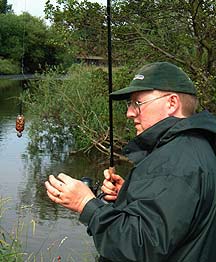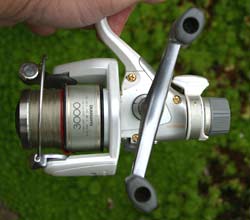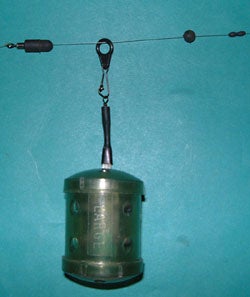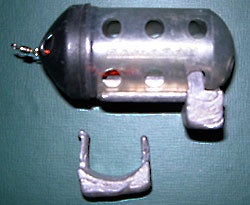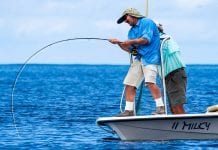| FIRST CLASS FISHING | |
Dave will cover a specific topic at a time in this bi-weekly column. The first section will be really basic with subsequent ones building on the skills covered previously. His aim is to explain things as simply and concisely as possible and will assume that the reader knows absolutely nothing about the subject. |
Big River Feeder Fishing
The Tackle For several reasons this method involves using sturdy gear. At times you are going to be casting weights of 2 to 4 oz into heavy currents, so all the equipment from reel to terminal rigs has to able to cope with the forces and strains this operation inflicts on your tackle. You are also going to be, hopefully, hooking powerful fish such as barbel and chub that know all about using the strong flows of the river to their advantage. Hence your tackle has to be up to the job. The rod needs to be a purpose built medium to heavy feeder rod, with a length of at least 12ft, with 13ft preferable to keep line off the surface of the water and pick up line through the current at distance. It will have a fairly stiff action through the butt and middle sections and only be slightly more forgiving in the top section. But having said that the ideal rod won’t be so rigid as to impair casting a feeder a fair distance or overly risk tearing the hook from a fish’s mouth. Quivertips will be needed in the 2 to 4 oz range, depending on the power of the current. Quivers of this rating will often be made of carbon fibre as they are more rigid than the glass fibre versions, but rigid tips are the order of the day as you don’t want them bending too much with just the pull of the current and bites are likely to be quite positive.
Load the reel with 6lb mono line. This may sound excessive if the target fish are chub or bream in the 2 to 4lb bracket, but remember, you are also taking account of casting weights of 3 and 4 oz which are accelerating to high speed on the cast. Any lighter reel line and you will be in danger of ‘cracking off’ your feeder with a clumsy cast. Feeder Rigs The terminal tackle, as with most feeder fishing, is relatively simple. There are two rigs here that I will show you, though the first is the most common and used for 95% of situations. The second, in particular circumstances, can give you a real edge when fish are feeding hard.
The rubber float stops and first rubber bead are not entirely necessary, but I add them to prevent the feeder running too far up the mainline on the cast, as can happen when casting a reasonable distance or when using larger hook baits. The second rig I want to show you is the in-line feeder rig. I use this rig when fish are feeding very confidently in large numbers, competing hard for the bait to the extent that they actually attack the feeder to get at the bait inside. The fish respond to the splash of the feeder hitting the water and rush to it, banging the feeder as it drops to the river bed. In this scenario it is pointless having the hook bait 2ft or more away from the feeder as it is probably looking at a fishes tail rather than its mouth most of the time and doesn’t get picked up before the feed in the feeder disappears. So for this rig the hook link is just 3 to 4 inches long. The feeder itself is attached by having the mainline running through the centre of the feeder.
The hooklink I use is just 3-4 inches long which keeps the hookbait right next to the feeder and will quickly be taken as fish attack the feeder. Unfortunately, fish don’t often behave this way and are usually far more cautious, so this rig only comes into play occasionally, but boy it’s fun when it happens! Choosing the feeder size and weight Blockend feeders for river fishing come in varying shapes and sizes and the make you use is purely down to personal preference. Some people like the cylindrical feeders while others prefer flattened versions, especially in larger sizes as they feel they hold better on the river bed in strong currents. Personally I like the Kamasan Black Cap feeders for the running feeder rig. The physical size of the feeder is usually governed by the amount of weight the feeder has to carry. A feeder carrying 2 or more ounces of lead has to be of a certain physical size obviously, while a 1oz feeder can be a bit smaller.
Baits By far the most popular hookbaits for this style of fishing are maggot and caster, though sweetcorn, luncheon meat and pellets work as well or better on any given day. For the feeder don’t ignore hempseed. Hempseed is a great attractor for most coarse fish and works exceptionally well with this method of fishing. Combine hookbait samples with hempseed in the feeder to create a superb bed of feed for fish to home in on. Build the Swim This type of fishing is about pulling fish up river from downstream to feed on a bed of bait. The feed is introduced through constant casting of the feeder loaded with your chosen bait into the same general area of the swim. Don’t stop feeding if bites do not come straight away. Keep casting that feeder every two to three minutes, If inexperienced anglers don’t get indications that there are fish around after five or six casts they tend to stop adding bait. They get frightened of putting any more feed in because there are no fish to eat what’s already there. Big mistake. If you keep feeding and build up the bed of bait fish will more often than not switch on to the feed and bites will come thick and fast. It may take a couple of hours, but don’t be put off. Shoals of barbel and chub especially can get through an enormous amount of feed and often need a lot to get them going in the first place. Fishing the Feeder The rod needs to be fished on rests. The more powerful the current the higher you should attempt to set the rod tip to keep as much line as possible off the surface of the water. For big, powerful rivers like the Severn when they are pushing through I will fish standing up with the rod set on two tall rests with the back rest set at waist height and the front rest as high as I can get it so the rod tip is way over my head. The idea here is to reduce as much as possible the drag inflicted on the line by the current and thus reducing the amount of lead you need to hold bottom. Casts should be made downstream and across the river to your chosen point. Keep the rod tip high and the line fairly tight to the feeder and ‘feel’ for the feeder hitting the riverbed. Gently position the rod onto the rests and tighten up to put a slight bend into the quivertip. Bites will either indicate as a sharp pull down on the tip or the quiver will spring back straight if a fish dislodges the feeder. In either scenario strike by sweeping the rod up and back to set the hook. That’s it for part 5. In part 6 of this legering series I will be moving back onto stillwater and looking at method feeder fishing for carp on commercial waters . See you then. |












